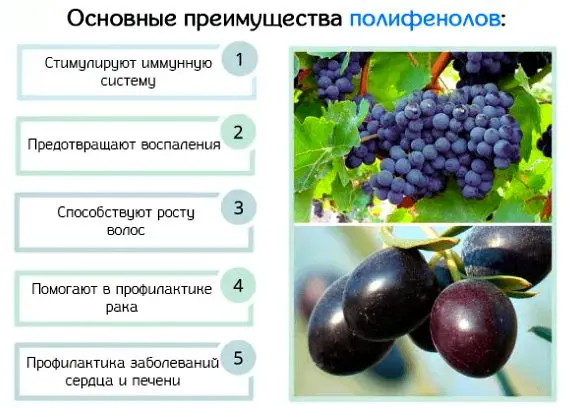😉 Hello everyone! Thank you for choosing the article “Polyphenols: what it is, their properties and mission” on this site!
The World Health Organization keeps reminding that a person should consume five servings of fruits, berries, vegetables every day. But is it only so as not to get fat?
Of course, the main benefit of edible fruit is not low calorie content. Plant food includes vitamins, minerals, salts, organic acids, fiber … And many other “longevity substances”, including polyphenols. What are these particles, and why do health professionals sing the praises of them?
Polyphenols: what is it
Polyphenols are complex compounds characteristic primarily of plant organisms. In their structure, they perform clear functions:
- Protect from exposure to ultraviolet radiation.
- Protect against fungi and mold.
- Scare away harmful insects.
- They are responsible for the resistance of plants to diseases.
In essence, it is a mechanism formed by nature to protect itself. But this is not surprising, but something else. Once inside a person, plant polyphenols perform the same task – they fight pathogens and strengthen immunity.
But that’s not the only reason fruits and root vegetables should be on the menu every day. Polyphenols are very diverse and affect all human systems and organs.
The most extensive groups of polyphenols are flavonoids and phenolic acids. Flavonoids are divided into 10 more groups, among which, for example, substances such as anthocyanins, catechins, flavones. Many studies have shown that flavonoids are capable of:
- regulate blood pressure;
- increase the elasticity of arteries and veins;
- reduce capillary fragility;
- streamline your heart rate;
- reduce the level of “bad cholesterol”;
- prevent platelet accumulation and blood clots;
- suppress inflammatory reactions.
The benefits of polyphenols
There is also evidence that bioflavonoids inhibit the generation and spread of malignant cells. Phenolic acids enhance the properties of flavonoids. And they also:
- normalize the condition of the thyroid gland;
- stimulate bile formation;
- prevent the deposition of stones in the bile and urinary canals.
All polyphenols – both flavonoids and phenolic acids – are excellent antioxidants. As well as essential vitamins, they protect our cells from the aggression of free radicals, and our DNA from damage and rupture.

What foods contain polyphenols
The best suppliers of the first group of polyphenols, that is, flavonoids, are:
- dark grapes, juices, concentrates and wine from such grapes;
- persimmon;
- blueberries, sea buckthorn, currants, blackberries, strawberries, cherries;
- green tea;
- citrus zest;
- dark chocolate;
- broccoli, spinach;
- peel of apples;
- red onions and hot yellow peppers;
- soya beans;
- almond;
- tomatoes, eggplants.
Do not forget that there are more than four thousand (!) Different flavonoids. Therefore, diversity is a sure way to saturate the body with their optimal amount.
Phenolic acids (the second, largest group of polyphenols) are concentrated in the following fruits:
- hawthorn;
- chokeberry;
- propolis;
- flax seeds;
- elder;
- cloves, anise, oregano, mint, rosemary, basil, sage;
- noble (edible) chestnut.
Actually, any fruit, vegetable, berry, spice is full of polyphenols – substances that science relies on as “cures for old age”.
😉 If you find the information “Polyphenols: What It Is” useful, share it with your friends in social media. networks. Come back to this site: a lot of interesting things to come!









